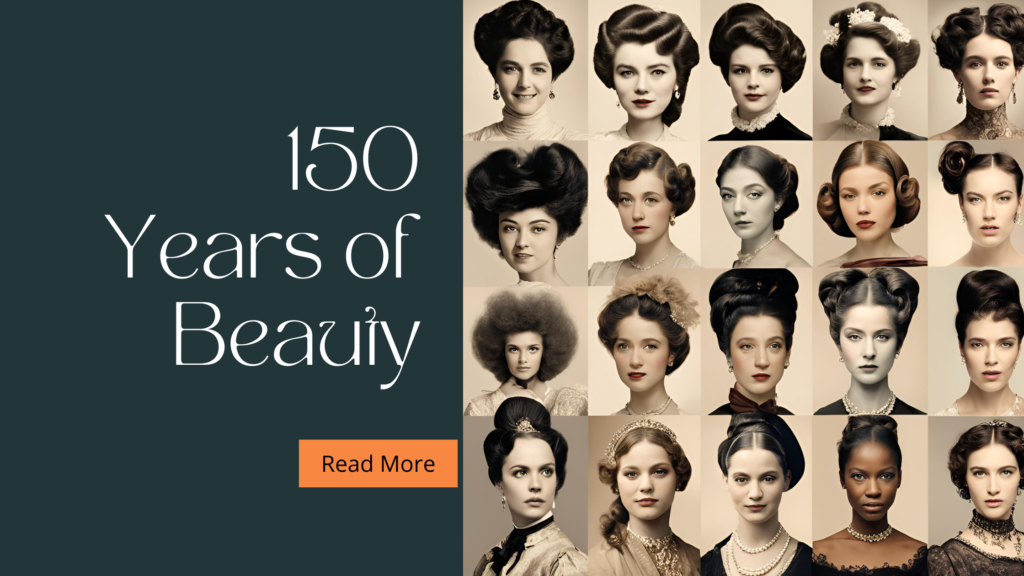
1870s-1920s: From Subtle Improvements
In the late 19th century, social mores said women should appear more natural.
But onstage and in their theatrical lives, actresses like Sarah Bernhardt wore a great deal of makeup – including kohl eyeliner and rouged cheeks.
The commercial beauty industry took off in the 19th century when brands like Ponds (1846) and Pears’ Soap (1807) began marketing their skincare products.
However, for a long time, many in the West associated makeup with actresses, prostitutes, or other socially marginalized women.
The Modern Makeup Kit: The 1920s-1940s
They shrugged off the constraints of the Edwardian era and beveled faces for a daring look that was unabashedly androgynous.
Flappers screamed scarlet lips, knock-’em-dead eye makeup in a sultry palette of kohl pencils and shadows, and plucked eyebrows.
Clara Bow and her trademark pouty heart-shaped lips and Louise Brooks with her chignon-cropped hairstyle from the silent film era were also part of the phenomenon as leading examples of smoldering dark eye makeup. They epitomized the icons of flapper chic.
Polish-American inventor Max Factor has been called the “founder of makeup.” When he developed the first commercially available compressed face powder and lip and eye palettes set on wands instead of pots, it really altered the nature of the makeup game.
These palettes, known as the “Max Factor Makeup Kits,” paved the way for the flapper experience to go behind the closed doors of the everyday woman’s home.
1940s-1960s: Hollywood Glamour Meets all American Look
The Second World War brought about a need for practical and resourceful makeup.
It became much more subdued, highlighting healthy skin and strong brows again to exhibit a sense of power and national pride.
However, the end of the war in 1945 flung open the gates once again to high fashion and Hollywood glam.
Marilyn Monroe, with her famous red lips, winged eyeliner, and ivory-like skin, and Elizabeth Taylor, with her famously comprehensive cat eye and long, dramatic lashes, were the latest trendsetters in makeup for women.
Meanwhile, the low end of “drugstore” brands and industries like Revlon were discovered in 1932 with a mandate to produce cheaper lipstick and nail polish in more colors. This only further democratized makeup as a necessity in a woman’s life.
1960s-1970s: Counterculture and Individuality
It was this sense of liberation moving into a new cultural world in the 1960s and 1970s.
Makeup was all about self-expression, and no looking back at the golden days of Hollywood, where glamour was controlled to perfection.
It was all about bright colors, glitter, and bold application techniques.
Quite naturally, the thin British model Twiggy, with enormous oval eyes and painted top lashes only, and pale lips, quite iconically, signifies the markers of a bold new beauty.
Cher, the queen of polymorphous self-reinvention with dramatic smoky eye makeup, and David Bowie, with his bouffant orange hair and makeup beyond gender, were part of it all.
1980s-2000s: Power Dressing and Diversity
The ’80s are all about heavy colors and even stronger application: bright eyeshadows in blues, greens, purples, blush high on the cheekbones, and a very defined lip.
Supermodels like Cindy Crawford and Naomi Campbell heralded the arrival of new overarching ideals of beauty, whereby the very athletic and healthy became beautiful.
The ’90s found more of a return to a natural look: skin that looked healthy and illuminated and brown tones used in lipstick and eyeshadow.
Men’s makeup started gaining ground, and M.A.C., created in 1984, helped generate a more inclusive offer with a wide range of shades and support for the LGBTQ+ community.
2000s-Present: An Era of Inclusivity, Innovation, and the Rise of Social Media
But in the 21st century, it is in the continuous move towards embracing diversity where Rihanna’s Fenty Beauty comes in — first launched in 2017, it broke all existing notions with its most extensive range of different shades of foundation for a much more comprehensive range of skin tone variances.
Launched in 2017, K.K.W. Beauty by Kim Kardashian made contouring accessible to everyone.
Social media tutorials empower people to sculpt and define their features at home.
Contouring is part of our everyday language, with YouTube tutorials turning regular folks into makeup artists and sharing tips and favorite products with the masses.
Korean and J-beauty trends, now focusing on skin health, underpinned by innovative products such as B.B. creams and sheet masks, have taken the world by storm.
The future of beauty harbors nothing but innovation, as in the assurance of clean ingredients, sustainability, and adaptability in the face of the consistent redefinition of beauty.
Makeup has moved from that tool of subtle change to the stage of self-expression and the flesh of our changing cultural behemoth, sewing itself into the fabric of life.